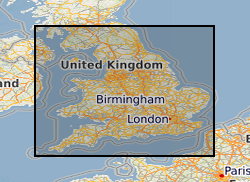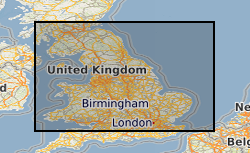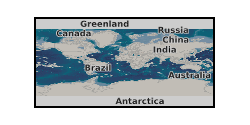1990
Type of resources
Topics
Keywords
Contact for the resource
Provided by
Years
Formats
Representation types
Update frequencies
Scale
Resolution
-
The Airborne Arctic Stratospheric Expedition (AASE) which was based in Stavanger, Norway during January and February, 1989, was designed to study the production and loss mechanisms of ozone in the north polar stratospheric environment, and the effect on ozone distribution of the Arctic polar vortex and of the cold temperatures associated with the formation of Polar Stratospheric Clouds (PSC). This dataset contains analyses of potential vorticity and pressure on constant potential temperature surfaces.
-
The NASA Surface Radiation Budget (SRB) project computes Top-of atmosphere and Surface radiative fluxes at a 1ox 1o spatial scale for both shortwave (0.28– 4 mm) and longwave (4 mm) wavelengths. This dataset collection contains Version 1.1 Surface Radiation Budget (SRB) shortwave products for the period from March 1985 until December 1988 as produced by the World Climate Research Programme's (WCRP) SRB Satellite Data Analysis Center (SDAC). The data are derived from results from the International Satellite Cloud Climatology Project (ISCCP) and the Earth Radiation Budget Experiment (ERBE).
-
The Airborne Arctic Stratospheric Expedition (AASE) which was based in Stavanger, Norway during January and February, 1989, was designed to study the production and loss mechanisms of ozone in the north polar stratospheric environment, and the effect on ozone distribution of the Arctic polar vortex and of the cold temperatures associated with the formation of Polar Stratospheric Clouds (PSC). The dataset collection consists of measurements of chemical and dynamical parameters collected onboard the NASA ER-2 and DC-8 aircraft (for example, ClO, BrO, HCl, O3, NOx, N2, HNO3 and CH4, whole air samples and aerosol measurements). In addition, there are ozonesonde soundings from three stations (Angmagssalik and Scoresbysund, Greenland, and Lerwick, U.K.), aerosol and temperature profiles from NASA's SAM II satellite, and selected radiosonde soundings from stations in the region of the experiment. Theory teams provided calculations of: potential vorticity along the ER-2 flight path; cross-sections of potential vorticity, temperature, and geopotential heights along the DC-8 flight path; cross-sections of Clx, Fx, HCl, HNO3, and NOy along the DC-8 flight path; global grid point values of temperature, geopotential heights, and horizontal winds on selected pressure surfaces; northern hemispheric grid point values of potential vorticity and pressure on selected potential temperature surfaces.
-
The Earth Radiation Budget Experiment (ERBE) instrument aboard the NASA Earth Radiation Budget Satellite (ERBS) was launched from the Space Shuttle Challenger in October 1984 (STS-41G). The ERBE instrument's main aim was to provide accurate measurements of incoming solar energy and shortwave and longwave radiation reflected or emitted from the Earth back into space. This dataset collection contains colour images (shortwave/longwave/net radiation, albedo, clear-sky albedo, clear-sky shortwave/longwave/net radiation, and shortwave/longwave/net cloud forcing) from scanning radiometers on the three ERBE satellites and for combined satellite cases. Monthly average values are included for the time periods during which the scanners were operational.
-
This dataset consists of combined data from the Earth Radiation Budget Experiment (ERBE) instruments on the Earth Radiaition Budget Satellite (ERBS) and the 10th NOAA Sun-synchronous operational satellites (NOAA-9). ERBS was launched in October 1984 by the Space Shuttle Challenger (STS-41G) into an orbit at 603-km altitude, 57-deg. inclination. NOAA-10 operated at an altitude of 833-km, with an equatorial crossing local time of 0730, having been launched in November 1986. The ERBE instrument's main aim was to provide accurate measurements of incoming solar energy and shortwave and longwave radiation reflected or emitted from the Earth back into space. This dataset contains colour images (shortwave/longwave/net radiation, albedo, clear-sky albedo, clear-sky shortwave/longwave/net radiation, and shortwave/longwave/net cloud forcing) from scanning radiometers on the NOAA-10 ERBE satellites and for combined satellite cases. Monthly average values are included for the time periods during which the scanners were operational.
-
This dataset consists of data from the Earth Radiation Budget Experiment (ERBE) instrument on the 10th NOAA Sun-synchronous operational satellites (NOAA-10). NOAA-10 operated at an altitude of 833-km, with an equatorial crossing local time of 0730, having been launched in November 1986. The ERBE instrument's main aim was to provide accurate measurements of incoming solar energy and shortwave and longwave radiation reflected or emitted from the Earth back into space. This dataset contains colour images (shortwave/longwave/net radiation, albedo, clear-sky albedo, clear-sky shortwave/longwave/net radiation, and shortwave/longwave/net cloud forcing) from scanning radiometer on the NOAA-10 satellite. Monthly average values are included for the time periods during which the scanners were operational. This dataset is public, though NASA noted that this is intended for research purposes and the data has no commercial value.
-

Oracle index to records of some 3500 waste sites in England and Wales identified by BGS as part of a survey carried out on behalf of the Departement of the Environment in 1973. The index has been corrected and updated to a limited extent, but the data itself has not been changed. The data was collected in 1972 and the information reflects the knowledge at that time. It does not reflect current interpretation. Not all authorities made returns and there are not records for all of the sites listed. However, the data is an invaluable source of information about pre-1974 sites. Information includes site name, location and risks to aquifers. It should be noted that the assessments were carried out when the data was collected and may not reflect current interpretation.
-
This dataset consists of data from the Earth Radiation Budget Experiment (ERBE) instrument on the 9th NOAA Sun-synchronous operational satellites (NOAA-9). NOAA-9 operated at an altitude of 852-km, with an equatorial crossing local time of 1430, having been launched in December 1984. The ERBE instrument's main aim was to provide accurate measurements of incoming solar energy and shortwave and longwave radiation reflected or emitted from the Earth back into space. This dataset contains colour images (shortwave/longwave/net radiation, albedo, clear-sky albedo, clear-sky shortwave/longwave/net radiation, and shortwave/longwave/net cloud forcing) from scanning radiometer on the NOAA-9 satellite. Monthly average values are included for the time periods during which the scanners were operational. This dataset is public, though NASA noted that this is intended for research purposes and the data has no commercial value.
-

BGS holds a disaster recovery copy of the microfiche of the statutory mine abandonment plans for the Coal Authority. This collection is an incomplete copy of the mine plans deposited with the Coal Authority and held on behalf of the Health and Safety Executive under statutory legislation. Not for public use.
-

The Seismic Line Index database stores summary administrative information about the collection of printed seismic sections, Original Seismic Sections dataset (ORIGSEISECS). This includes: details of data ownership or source, date of acquisition, purpose of survey, confidentiality, media, survey acquisition and processing parameters, and storage location in BGS. Almost all data are within the UK Onshore area; although there are some UK near-shore and offshore (North Sea, Irish Sea) and foreign data. Most data were acquired for commercial hydrocarbon exploration and subsequently provided to BGS for use on specific projects. Some data were acquired by BGS and other public-sector bodies, e.g. BIRPS (British Institutes Reflection Profiling Syndicate), for academic research. There is also scope to add relevant information about the data held in Copy Seismic Sections (COPYSEISECS) and Original Seismic Shotpoint Location Maps (ORIGSPMAPS) datasets.
 NERC Data Catalogue Service
NERC Data Catalogue Service